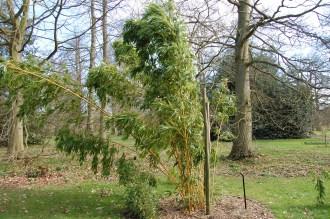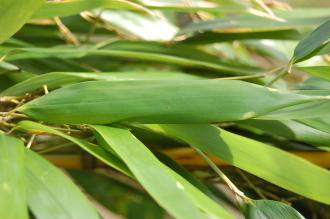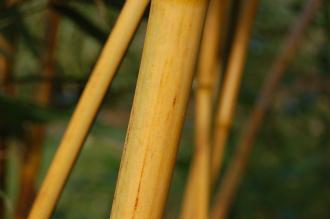
Phyllostachys aureosulcata (01/03/2015, Kew Gardens, London)
Position: Sun to light shade
Flowering Period: N/A
Soil: Moist, well drained
Eventual Height: 9m
Eventual Spread: 6m
Hardiness: 5a, 5b, 6b, 7a, 7b, 8a, 8b, 9a, 9b, 10a
Family: Poaceae
Phyllostachys aureosulcata is an evergreen running bamboo with an upright habit. Its glossy light green leaves are linear with entire margins and are up to 12cm long and 14mm broad. Its light green and golden streaked culms are up to 4cm in diameter. This plant produces underground rhizomes which aids its spread.

Phyllostachys aureosulcata Leaf (01/03/2015, Kew Gardens, London)
Phyllostachys aureosulcata, commonly known as Yellow Groove Bamboo, is native to south east China. In its native habitat it grows at woodland edges and clearings. This bamboo is considered an invasive plant in some parts of the USA.
The etymological root of the binomial name Phyllostachys is derived from the Greek phyllon meaning ‘leaf’ and stachys meaning ‘spike’. Aureosulcata is derived from the Latin aurea meaning ‘golden’ and sulcus meaning ‘furrow’.
The landscape architect may find Phyllostachys aureosulcata useful as a useful as a screening bamboo. A root barrier may be used to contain its spread. It should be noted that at the colder part of its range its leaves will fall of and the above ground part may die back to below ground level during the winter months.
Ecologically, Phyllostachys aureosulcata is of little wildlife value in the UK.

Phyllostachys aureosulcata Cane (01/03/2015, Kew Gardens, London)
The Royal Horticultural Society has given the form Phyllostachys aureosulcata f. spectabilis their prestigious Award of Garden Merit in 2002.
Phyllostachys aureosulcata prefers moist, humus rich, well-drained soils. It tolerates most pH of soil.
Phyllostachys aureosulcata requires little to no maintenance. The plant may be thinned out if required and spent canes may be cut back to the ground level. Its lower leaves may be removed to expose its attractive canes.

